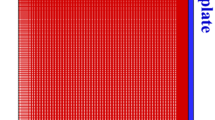Abstract
A coupled model of continuous casting with mold oscillation was established including multiphase flow, heat transfer and solidification. The process of initial solidification and the formation of oscillation marks were analyzed. The accuracy of the model was verified by comparing the depth of oscillation marks and slag consumption with the measurement by the plant. The main results showed that during the negative strip stage, part of the slag near the initial solidified shell affected by the downward movement of the slag rim was squeezed out from the slag channel to the slag pool, meanwhile pressure difference of shell and heat flux was maximized, shell grew rapidly. The oscillation marks were formed during the negative strip stage. The effect of interfacial tension on the oscillating marks formation was quantitatively analyzed. These results provide theoretical support to improve the quality of the slabs.











Similar content being viewed by others
Data Availability
The data that support the findings of this study are available on request from the corresponding author upon reasonable request.
References
Zhang X, Wang Q, Yang W, Wang S, and Zhang L, Metall Mater Trans B 49 (2018) 2533. https://doi.org/10.1007/s11663-018-1339-z
Zhang X, Ren Y, Zhang L, and Yang W, Metall Mater Trans B 49 (2018) 3186. https://doi.org/10.1007/s11663-018-1366-9
Zhang X, Ren Y, and Zhang L, Metall Mater Trans A 49 (2018) 5469. https://doi.org/10.1007/s11661-018-4860-4
Tomono H, Kurz W, and Heinemann W, Metall Trans B 12 (1981) 409. https://doi.org/10.1007/BF02654475
Ramirez Lopez P E, Mills K C, Lee P D, and Santillana B, Metall Mater Trans B 43 (2012) 109. https://doi.org/10.1007/s11663-011-9583-5
Ramirez Lopez P, Sjöström U, Jonsson T, Lee P, Mills K, Petäjäjärvi M, and Pirinen J, Industrial Application of a Numerical Model to Simulate Lubrication, Mould Oscillation, Solidification and Defect Formation during Continuous Casting (2012).
Zhang H, Wang W, Ma F, and Zhou L, Metall Mater Trans B 46 (2015) 2361. https://doi.org/10.1007/s11663-015-0413-z
Zhang H, and Wang W, Metall Mater Trans B 47 (2016) 920. https://doi.org/10.1007/s11663-015-0579-4
Yan X, Jia B, Wang Q, He S, and Wang Q, Metals 9 (2019) 418. https://doi.org/10.3390/met9040418
Yang J I E, Meng X, Wang N, and Zhu M, Metall Mater Trans B 48 (2017) 1230. https://doi.org/10.1007/s11663-016-0880-x
Yang J, Meng X, and Zhu M, ISIJ Int 58 (2018) 2071. https://doi.org/10.2355/isijinternational.ISIJINT-2018-169
Yang J, Chen D, Long M, and Duan H, Metals 10 (2020) 51. https://doi.org/10.3390/met10010051
Vynnycky M, and Zambrano M, Appl Math Model 63 (2018) 243. https://doi.org/10.1016/j.apm.2018.06.029
Zhang S, Wang Q, He S, and Wang Q, Metall Mater Trans B 49 (2018) 2038. https://doi.org/10.1007/s11663-018-1267-y
Zhang X-B, Chen W, and Zhang L-F, China Foundry 14 (2017) 416. https://doi.org/10.1007/s41230-017-7171-2
Zhang X, Chen W, Scheller P R, Ren Y, and Zhang L, JOM 71 (2019) 78. https://doi.org/10.1007/s11837-018-3177-5
Zhang X, Chen W, Ren Y, and Zhang L, Metall Mater Trans B 50 (2019) 1444. https://doi.org/10.1007/s11663-019-01570-8
Ji J, Mao Y, Zhang X, Chen W, Zhang L, and Wang Q, Steel Res Int 92 (2021) 2000714. https://doi.org/10.1002/srin.202000714
Ji J, Cui Y, Zhang X, Wang Q, He S, and Wang Q, Steel Res Int 92 (2021) 2100101. https://doi.org/10.1002/srin.202100101
Ji J, Cui Y, Zhang X, Wang Q, He S, and Wang Q, Steel Res Int 92 (2021) 2000636. https://doi.org/10.1002/srin.202000636
Brackbill J U, Kothe D B, and Zemach C, J Comput Phys 100 (1992) 335. https://doi.org/10.1016/0021-9991(92)90240-Y
Blazek J, Chapter 7—turbulence modeling. in Computational Fluid Dynamics: Principles and Applications, (ed) Blazek J, Butterworth-Heinemann, Oxford (2015), p 213.
Zhou C, Zhang X, Wang F, and Zhang F, IEEE Access 8 (2020) 1235. https://doi.org/10.1109/ACCESS.2019.2958057
Shin H-J, Kim S-H, Thomas B G, Lee G-G, Park J-M, and Sengupta J, ISIJ Int 46 (2006) 1635. https://doi.org/10.2355/isijinternational.46.1635
Mills K C, and Fox A B, ISIJ Int 43 (2003) 1479. https://doi.org/10.2355/isijinternational.43.1479
Matsushita A, Isogami K, Temma M, Ninomiya T, and Tsutsumi K, Trans Iron Steel Inst Jpn 28 (1988) 531. https://doi.org/10.2355/isijinternational1966.28.531
Badri A, Natarajan T T, Snyder C C, Powers K D, Mannion F J, Byrne M, and Cramb A W, Metall Mater Trans B 36 (2005) 373. https://doi.org/10.1007/s11663-005-0066-4
Miyake T, Morishita M, Nakata H, and Kokita M, ISIJ Int 46 (2006) 1817. https://doi.org/10.2355/isijinternational.46.1817
Acknowledgements
This study was funded by Hebei Province Natural Science Fund (Grant Number E2020203128) and Hebei Education Department Higher Education Science and Technology Program (Grant Number ZD2021106).
Author information
Authors and Affiliations
Corresponding author
Ethics declarations
Conflict of interest
The authors declare that they have no conflict of interest.
Additional information
Publisher's Note
Springer Nature remains neutral with regard to jurisdictional claims in published maps and institutional affiliations.
Rights and permissions
Springer Nature or its licensor (e.g. a society or other partner) holds exclusive rights to this article under a publishing agreement with the author(s) or other rightsholder(s); author self-archiving of the accepted manuscript version of this article is solely governed by the terms of such publishing agreement and applicable law.
About this article
Cite this article
Cao, M., Liu, Y., Yu, B. et al. Modeling Study on the Initial Solidification and Formation of Oscillation Marks in Continuous Casting Mold. Trans Indian Inst Met 77, 51–60 (2024). https://doi.org/10.1007/s12666-023-03040-x
Received:
Accepted:
Published:
Issue Date:
DOI: https://doi.org/10.1007/s12666-023-03040-x




